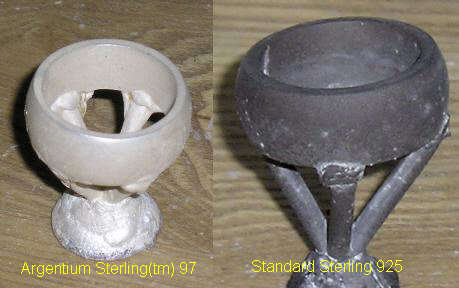The above image shows no firescale after casting with Argentium Sterling vs. traditional sterling silver
What is Argentium Sterling Silver?
Argentium Sterling Silver is a proprietary Sterling Silver that was developed as a result of research done by Peter Johns at the Art and Design Research Institute, School of Art & Design, Middlesex University.
The metal is a modern alloy of sterling silver which is traditionally 92.5% silver and 7.5% copper. The alloy differs from traditional sterling silver in that a very small portion of the copper is replaced with metalloid germanium. Because the alloy is still 92.5% silver it can still be referred to as sterling silver.
The advantages of Argentium Sterling Silver
Using Argentium Sterling Silver has several advantages, here are a few:
Firescale:
Firescale has always been a problem for those working with sterling silver. Firescale occurs when the copper in the sterling silver oxidizes below the surface of the metal causing a reddish or dark black discoloration. Because this discoloration is not simply on the surface of the metal, it cannot easily be removed.
Often large-scale manufacturers of jewelry are required to plate the surface of the sterling silver in order to cover up the firescale. Unfortunately, the plating can change the appearance of the metal and can cause problems for individuals with specific metal allergies.
Because the germanium oxidizes faster than the copper in the Argentium Sterling Silver alloy, the problem of firescale is eliminated.
Tarnish Resistance:
Another problem that traditional sterling silver has is its tendency to tarnish. Due to a clear germanium oxide layer that forms over the top of the Argentium Sterling Silver alloy, the copper is protected somewhat to exposure to oxygen which creates a much slower rate of tarnish.
Increased ductility and malleability:
Increased ductility or alloys’ ability to be stretched into a wire, is another advantage that Argentium Sterling Silver has over traditional sterling silver. Malleability is the material’s ability to form a thin sheet by hammering or rolling can also be increased by proper quenching of the metal after heating.
Precipitation and Heat hardening:
Because pure silver is such a soft metal, it is seldom used for jewelry. This is why most jewelry is made of sterling silver. The copper that is added to sterling silver makes the alloy harder and more durable. Argentium Sterling Silver can even be made harder, in some cases nearly twice as hard, by precipitation or heat hardening
Easier Fusing:
Fusing has traditionally been a difficult task using sterling silver. Most jewelry created by fusing has usually been made using pure silver or high carat gold. The problem with using these metals is that they are very soft making them easily damaged when used in jewelry.
The main reason that traditional sterling silver is difficult to fuse properly is that the surfaces must be very clean. When traditional sterling silver is heated, a layer of copper oxide is immediately formed on the surface of the alloy. This problem is eliminated when using Argentium Sterling Silver.
Allergy Resistant:
I can’t officially say that someone that has allergies to sterling silver is going to be able to wear Argentium, however, my preliminary studies have shown that it is quite likely that a person that is allergic to Sterling silver will, in fact, be able to wear Argentium Sterling Silver. What I believe is the difference is the Argentium Oxide layer forms on the outer layer of the jewelry.
The most common metal allergy by far is Nickel. Nickel is commonly used as a base coating when plating sterling silver jewelry to protect the jewelry from tarnishing. When the very thin outer layer is worn off, the nickel layer is exposed leaving the wearer at risk of a nickel allergy reaction. Because there is no firescale problem with Argentium Sterling Silver, there is no need to plate the Argentium Sterling.
Another metal that people are sometimes allergic to is copper. Copper is used in creating both 10K-23K gold jewelry as well as sterling silver jewelry. If the wearer is allergic to copper, often the wearer finds themselves only able to wear 24K gold or some other metal. My tests, as well as tests done by others, indicate that someone that normally can only wear 24K gold, may be able to wear Argentium Sterling Silver.
Summary
So, what is Argentium Sterling Silver? It’s a wonderful proprietary sterling silver that has properties that are quite a bit different than standard sterling silver. Tarnish resistance, ease of fusing and workability, and allergy resistance are just a few of the wonderful properties of Argentium Sterling Silver.

